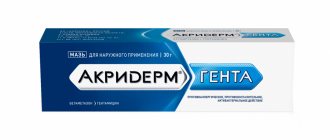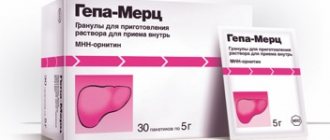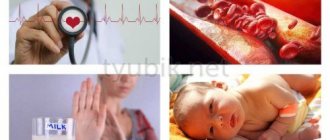Compound
| Lyophilisate for preparing a solution for intramuscular administration of 75 IU FSH + 75 IU LH | 1 fl. |
| active substance: | |
| menotropins | 75 ME |
| which corresponds to 75 IU FSH, 75 IU LH | |
| excipients: lactose monohydrate - 20 mg; polysorbate-20 - 0.1 mg; sodium hydroxide 0.0008–0.003 mg; hydrochloric acid 0–0.0005 mg | |
| solvent ampoule (0.9% sodium chloride solution): sodium chloride - 9 mg, hydrochloric acid 0.007 mg - 0.02 mg; water for injection - up to 1 ml |
Pharmacodynamics
Menopur® is a highly purified human menopausal gonadotropin (HMG) preparation. The drug belongs to the group of menotropins, contains FSH and LH in a 1:1 ratio. obtained by extraction from the urine of postmenopausal women. Menopur® stimulates the growth and maturation of ovarian follicles, increases estrogen levels, and stimulates endometrial proliferation. Treatment with Menopur® is usually combined with the administration of human hCG (hCG) to induce final follicular maturation and the onset of ovulation.
Packaging, release form
Menopur is available in bottles with powder and ampoules with a solvent (saline solution, sterile water).
Three formats of FSH and LH dosages in a bottle are available:
- 75 IU (international units).
- 600 IU.
- 1200 IU.
Auxiliary components:
- lactose;
- sodium hydroxide;
- polysorbate 20;
- hydrochloric acid.
You can purchase a package of Menopur containing 5 or 10 bottles with 2 mg of dry substance and, accordingly, ampoules with 1 ml of injection water. In a drug with a dosage of 600 IU and 1200 IU, instead of ampoules, there may be syringes with a ready-made solvent.
Packages of Menopur in different dosages
Indications for Menopur®
Among women:
anovulation in polycystic ovary syndrome (if clomiphene therapy is ineffective);
controlled ovarian hyperstimulation to induce the growth of multiple follicles during assisted reproductive technologies (ART).
For men:
stimulation of spermatogenesis in azoospermia or oligoasthenospermia caused by primary or secondary hypogonadotropic hypogonadism (in combination with hCG drugs).
Operating principle
Menotropin is necessary for the timely and complete maturation of germ cells in women and men. For healthy folliculogenesis, as well as spermatogenesis, the ratio of folliculotropin and luteotropin must be equal, which is not always observed and leads to decreased fertility. In Menopur, the ratio between hormones is balanced, so the use of the product stimulates these processes.
In IVF protocols, the drug is prescribed to stimulate the formation of numerous follicles. It is usually combined with hCG (human chorionic gonadotropin).
There are two schemes for using drugs:
- Sequential - to induce ovulation or control hyperstimulation.
- Alternating - to stimulate spermatogenesis (Leydig cells).
Menotropin is a natural remedy that does not cause the formation of antibodies to it.
Contraindications
persistent enlargement of the ovaries, ovarian cysts (not caused by polycystic ovary syndrome);
abnormal development of the genital organs, uterine fibroids, incompatible with pregnancy;
metrorrhagia and other bleeding of unknown etiology;
ovarian, uterine and/or breast cancer;
prostate cancer, testicular tumor;
high concentration of FSH in primary ovarian failure;
pregnancy and lactation;
tumors of the hypothalamic-pituitary region;
androgen-dependent tumors;
hypersensitivity to the drug or its components.
If you have one of the listed diseases, you should definitely consult your doctor before taking the drug.
Carefully:
see "Special Instructions".
Features of dilution of the drug
Sometimes it may be necessary to administer a large dose of the drug or just several bottles at once. What is necessary and important to remember for this. So, the drug is diluted immediately before the administration itself. If you cannot carry out the manipulations yourself, then it is better to have it done by medical professionals. Having drawn the solvent into the syringe, it is injected into the bottle; after dissolving, the drug is drawn into the syringe and placed in the second bottle. And so on until the entire required dose has been collected.
Correct dilution of the drug
Side effects
Common (>1/100 to <1/10)
From the genitourinary system:
ovarian hyperstimulation syndrome (OHSS), pain in the lower abdomen.
From the nervous system:
headache.
From the digestive system:
abdominal pain, nausea, flatulence.
General reactions and reactions at the injection site:
pain, swelling and irritation at the injection site.
Men may experience gynecomastia.
The most serious side effect is OHSS and associated complications: thromboembolic syndrome and ovarian torsion. If any of the side effects indicated in the instructions worsen, or any other side effects not specified in the instructions develop, you should inform your doctor.
Menopur overdose, symptoms and treatment
Ovarian hyperstimulation syndrome may develop. Treatment is symptomatic. With a mild degree of hyperstimulation (grade I), accompanied by a slight enlargement of the ovaries (ovarian size 5–7 cm), increased secretion of steroid hormones and abdominal pain, there is no need to carry out special measures. The patient should be informed about the cause of this condition and monitored. In the second degree of hyperstimulation with the formation of ovarian cysts (ovarian size 8–10 cm), occurring with abdominal pain, nausea and vomiting, a thorough clinical examination should be carried out, and in the case of a high hemoglobin level, it may be necessary to replace the circulating blood volume by intravenous infusion. In case of III degree of hyperstimulation with the formation of large ovarian cysts (ovarian size 10 cm), manifested by ascites, hydrothorax, bloating, abdominal pain, dyspnea, retention of electrolytes in the body, increased hemoglobin levels and blood viscosity, platelet aggregation with the risk of thromboembolic complications, it is necessary urgent hospitalization.
Directions for use and doses
V/m
or
s/c
. The subcutaneous route of administration is preferable because it ensures the greatest absorption of the drug. Treatment with the drug should only be carried out under the supervision of a physician with appropriate specialization and experience in the treatment of infertility.
Recommendations for preparing the solution:
the injection solution must be prepared immediately before administration using the supplied solvent. Sudden shaking should be avoided. The solution is not suitable for use if it contains undissolved particles or is opaque. The dose of the drug described below is the same for both subcutaneous and intramuscular routes of administration.
The dose should be adjusted individually depending on the response of the ovaries. This requires monitoring the ovarian response to therapy in the form of ultrasound alone, and preferably in combination with dynamic measurement of estradiol concentration.
In women, unless otherwise prescribed, the following treatment regimen is recommended:
Anovulation (including polycystic ovary syndrome):
The goal of treatment with Menopur® is the development of one mature follicle, from which an oocyte will emerge after administration of hCG drugs. Treatment usually begins in the first 7 days of the menstrual cycle with a dose of 75–150 IU (1–2 bottles of the drug) per day for a week. In the absence of an ovarian response, the dose is gradually increased by 37.5 IU no more than 1 time per week until an increase in estrogen levels in the blood or follicular growth is registered, but not more than 75 IU. The maximum daily dose should not exceed 225 IU. If a therapeutic response is not achieved within 4 weeks, treatment should be discontinued and a new cycle should be started with a higher initial dose. Patients are recommended to use barrier methods of contraception until the onset of their next menstruation. If an optimal response to therapy is achieved, a single injection of 5000–10,000 IU hCG should be given the day after the last dose of Menopur®. The patient is recommended to have sexual intercourse or undergo intrauterine insemination on the day of hCG administration and the day after administration.
To stimulate the growth of multiple follicles during ART
Menopur® should be prescribed approximately 2 weeks after the start of treatment with GnRH agonists. The recommended initial daily dose of Menopur® is 150–225 IU during the first 5 days of treatment. If there is no ovarian response, the dose may be gradually increased. Dose changes should not exceed 150 IU at a time. The maximum daily dose of Menopur® should not exceed 450 IU; in most cases, the drug should not be administered for more than 20 days. If the treatment regimen does not require prior use of GnRH agonists, administration of Menopur should begin on the 2nd or 3rd day of the menstrual cycle. The recommended method of administration and the same doses of the drug as described above. When an optimal response to the therapy is achieved, a single injection of 10,000 IU hCG should be given to induce the final maturation of the follicle and prepare the release of a full-fledged egg. Patients should be closely monitored for 2 weeks after hCG administration. If there is an excessive reaction to treatment with Menopur®, therapy should be discontinued, hCG administration should be discontinued and barrier methods of contraception should be used until the next menstruation.
In men
Unless otherwise prescribed, the following treatment regimen is recommended:
For hypogonadotropic hypogonadism to stimulate spermatogenesis
Menopur® is prescribed if previous therapy with hCG drugs caused only an androgenic reaction without signs of increased spermatogenesis. In this case, treatment continues by administering 2000 IU of hCG 2 times a week along with injections of Menopur® 75 IU 3 times a week. Treatment according to this regimen should be continued for at least 4 months; if ineffective, treatment is continued by administering hCG 2000 IU 2 times a week, and 150 IU Menopur® 3 times a week. The status of spermatogenesis should be assessed monthly, and if there are no positive results within the next 3 months, treatment should be discontinued.
For idiopathic normogonadotropic oligospermia
5000 IU of hCG and 75–150 IU of Menopur® are administered weekly 3 times a week for 3 months.
To stimulate spermatogenesis
1000–3000 IU of hCG is administered 3 times a week until the concentration of testosterone in the blood normalizes. After this, for several months, 75–150 IU of Menopur® 3 times a week.
Instructions for administering the drug "Menopur"
Daily dose of Menopur for IVF
the standard is 75 IU or 150 IU. Treatment occurs under the control of estrogen levels over time. For this purpose, ultrasound and/or clinical blood tests are used.
If there is no increase in hormone levels, the dosage is increased until the levels begin to increase and reach the preovulatory level, after which the drug is stopped. With a rapid increase in estrogen, the dose is reduced. To further stimulate ovulation, hCG 5000–10,000 IU is administered. Over the next 9 days, 3 consecutive injections of hCG 5000 IU are given. The use of choriotropin helps prevent the development of corpus luteum insufficiency.
At the IVF stage, follicular growth is stimulated with the help of Menotropin alone, 75–300 IU daily. Or in combination with gonadotropin-releasing factor agonists or clomiphene. Before puncture of the follicle, an injection of hCG is given.
Men are given Menotropin 75 IU every day or 2-3 injections per week in combination with human chorionic gonadotropin 1000-2000 IU. The duration of the course aimed at improving spermatogenesis is up to three months. During treatment, hormone replacement therapy (testosterone) is discontinued. If the process of sperm formation has improved, then the patient is given maintenance doses of hCG.
The injection is given subcutaneously in the abdominal area. You need to mix the solvent with the powder in one bottle. Fill the syringe with the resulting clear solution and inject into the skin fold. Press the puncture with a swab containing alcohol. It is advisable to change the injection site daily. Usually the first injection is given by a health worker in a clinic, the rest - at home independently after thorough medical instructions.
special instructions
Before starting treatment, it is recommended to perform a semen analysis of the sexual partner; if necessary, treat hypothyroidism, adrenal insufficiency, hyperprolactinemia, tumors of the pituitary gland or hypothalamus. Gynecological examination during ovarian enlargement is carried out very carefully to avoid rupture of ovarian cysts.
After stimulating follicle maturation and ovulation, the possibility of multiple pregnancies during natural conception increases. In the case of ART, the likelihood of a multiple pregnancy depends on the number of oocytes injected.
The possibility of ectopic pregnancy should be borne in mind, especially with a history of fallopian tube diseases. The frequency of early and spontaneous abortions during pregnancy occurring after treatment with Menopur® is higher than in healthy patients, but comparable to that for infertility of other etiologies.
No connection has been established between the use of Menopur® and the occurrence or development of benign or malignant neoplasms of the reproductive organs.
The incidence of congenital malformations in newborns during ART is slightly higher than during natural conception. However, this is more likely to be related to the individual characteristics of the parents (age, sperm characteristics, etc.) than to Menopur®.
It should be remembered that patients with a body mass index ≥30 kg/m2 have an increased risk of developing thromboembolic complications.
Treatment with menotropin drugs can lead to the development of OHSS, which becomes clinically pronounced after the administration of hCG drugs and manifests itself in the formation of large ovarian cysts. This is combined with the accumulation of fluid in the abdominal cavity (ascites), pleural cavity (hydrothorax), accompanied by a decrease in the volume of urine excreted (oliguria), a decrease in blood pressure (hypotension) and blockage of blood vessels (thromboembolic phenomenon). Most often, OHSS occurs on the 7-10th day after ovulation, stimulated by the administration of hCG (less often during ART).
At the first signs of OHSS (abdominal pain, space-occupying formations in the lower abdomen palpable by a doctor or detected by ultrasound), treatment should be stopped immediately!
In the presence of pregnancy, the above-described phenomena become aggravated and their duration increases, which can threaten the patient’s life.
In cases of OHSS development, hCG should not be administered for the purpose of ovulation. During ART, the risk of OHSS can be reduced if the contents of all follicles are aspirated before ovulation.
During the treatment period, menotropins are ineffective in men with high concentrations of FSH in the blood.
Menopur® does not have a negative effect on the ability to drive a car or use other machinery.
Menopur lyof. 75ME No. 10 (10pcs/pack) - Instructions
Release form
Menopur is a lyophilisate that is used for further dilution and use as injections. The packaging of the drug is as follows: 2 ml bottle with lyophilisate + ampoule (1 ml) with solvent/5 sets/pack.
Compound
1 bottle of Menopur 75 IU contains menotropin (equivalent to follicle-stimulating hormone 75 IU, luteinizing hormone 75 IU).
Auxiliary components: sodium hydroxide, polysorbate-20, hydrochloric acid, lactose monohydrate. The solvent ampoule contains saline. solution.
pharmachologic effect
Menopur is a highly purified drug of menopausal human gonadotropin (HMG). Menopur contains purified human menopausal gonadotropin, which is obtained from the urine of women after menopause. The ratio of FSH and LH content is 1:1. When administered to women, it stimulates the production of estrogen and the maturation of follicles, as well as proliferative processes in the endometrium. When administered to men, the drug increases testosterone levels and stimulates spermatogenesis due to its effect on the cells of the seminiferous tubules.
Indications for use
For female patients, Menopur is used for: infertility due to disorders of the hypothalamic-pituitary system; stimulating the growth of multiple follicles using reproductive techniques.
For male patients, Menopur is used for: azoospermia associated with hypogonadtropic hypogonadism; oligoasthenospermia associated with hypogonadtropic hypogonadism.
Directions for use and dosage
The diluted Menopur lyophilisate can be administered subcutaneously or intramuscularly. The solution is prepared immediately before injection, and the contents of the ampoule included in the kit are used as a solvent.
For female infertility, treatment begins with Menopur 75 IU with 1-2 bottles/day. If there is no ovarian response, then the dosage is increased until the expected ovarian response is observed: estrogen levels increase and follicles grow. The dose is not changed until the estrogen concentration reaches the preovulatory level. If a sharp jump in estrogen concentration occurs, the dose is reduced.
To induce ovulation, Menopur is injected according to the usual regimen, then, a few days after the end of the regimen, it is administered once in concentrations of 5000-10000 IU.
To stimulate spermatogenesis, men are advised to administer the drug Menopur in dosages of 1000-3000 IU with a frequency of use 3 times a week. Therapy continues until testosterone concentrations normalize. After this, Menopur is used with the same frequency, but in quantities of 75-150 IU.
Side effects
The use of Menopur may be accompanied by: mastalgia; enlarged ovaries; nausea; ovarian hyperstimulation syndrome; formation of ovarian cysts; vomiting; arthralgia; oliguria; hypotension; gynecomastia; skin rash; colic; increase in body weight; redness of the injection area; swelling of the injection area; increase in temperature; itching; multiple pregnancy; the formation of antibodies to the active ingredients.
Contraindications
The drug Menopur is contraindicated for: pathologies of the thyroid gland; hyperprolactemia; diseases of the adrenal glands; tumors of the pituitary gland, hypothalamus; prostate cancer; persistent ovarian enlargement; lactation; hypersensitivity to drugs that contain LH, FSH, and auxiliary components; the presence of cysts not associated with polycystic disease; the presence of anomalies in the development of the genital organs that are not incompatible with pregnancy; uterine fibroids incompatible with pregnancy; vaginal bleeding of unknown cause; primary ovarian failure; androgen-dependent tumors; uterine cancer; oncological pathology of the ovaries; breast cancer; pregnancy.
Pregnancy and breastfeeding
Menopur is contraindicated during pregnancy or suspected pregnancy.
Interaction with other drugs
The drug Menopur can be combined with the drug Horagon to induce ovulation and stimulate spermatogenesis.
Mixing the injection solution with other drugs in the same syringe should not be allowed. With simultaneous therapy with clomiphene citrate, the follicle response increases. An increase in the dose of Menopur is necessary when treating with GRF agonists.
Overdose
There is no data on overdoses of Menopur in the official documentation.
Features of application
If therapy with Menopur is necessary, the patient must first be examined and find out if he has: hypothyroidism; hyperprolactemia; adrenal insufficiency; tumors of the hypothalamus, pituitary gland. If the diagnosis is confirmed, then before using the drug he is treated for the listed diseases. Hemoconcentration should also be corrected.
Necessary tests and procedures before prescribing the drug and during therapy with Menopur: determination of estradiol, ultrasound of the ovaries.
When using the drug, ovarian hyperstimulation may occur. As a result, large ovarian cysts are formed with complications in the form of ascites and hydrothorax. If this is confirmed, then treatment is immediately canceled or adjusted.
It should be remembered that with the development of ovarian hyperstimulation, hCG drugs are not administered orally to provoke ovulation.
Multiple pregnancies are a common result of the use of hMG drugs.
Storage conditions
The storage temperature of Menopur is up to 25 degrees Celsius. The shelf life of the lyophilisate is 2 years.
Vacation category
On prescription.
Synonyms of nosological groups
Category ICD-10 Synonyms of diseases according to ICD-10
| E23.0 Hypopituitarism | Anovulatory disorders |
| Simmonds disease | |
| Simmonds-Glinsky disease | |
| Secondary hypogonadism in men | |
| Secondary hypogonadotropic hypogonadism | |
| Hypogenitalism | |
| Hypogonadism | |
| Hypogonadism hypogonadotropic | |
| Hypogonadism pituitary | |
| Hypogonadism in men | |
| Hypogonadotropic hypogonadism | |
| Hypopituitrism | |
| Pituitary infantilism | |
| Cerebropituitary dwarfism | |
| Pituitary cachexia | |
| Diencephalic-pituitary cachexia | |
| Larona dwarfism | |
| Pituitary insufficiency | |
| Growth retardation in children with hypopituitarism | |
| Panhypopituitarism | |
| Primary hypogonadism | |
| Primary hypogonadotropic hypogonadism | |
| Kallmann syndrome | |
| Fertile eunuch syndrome | |
| Schehen's syndrome | |
| Sheehan syndrome | |
| Sheehan syndrome | |
| E28.2 Polycystic ovary syndrome | Polycystic ovary syndrome |
| Polycystic ovary syndrome | |
| Polycystic ovary syndrome | |
| Stein-Leventhal syndrome | |
| Stein-Leventhal syndrome | |
| Sclerocystic ovarian disease | |
| Stein-Leventhal syndrome | |
| E29 Testicular dysfunction | Hypofunction of the gonads in men |
| Androgenic dysfunction | |
| Dysfunction of the gonads | |
| Dysfunction of the gonads in men | |
| Underdevelopment of the genital organs in men | |
| Primary hypogonadism in men | |
| N46 Male infertility | Azoospermia |
| Asthenospermia | |
| Infertility | |
| Male infertility | |
| The marriage is barren | |
| Dispermia | |
| Spermatogenesis disorder | |
| Spermatogenesis disorders | |
| Oligoasthenozoospermia stage III-IV | |
| Oligoasthenospermia | |
| Oligozoospermia | |
| Oligospermia | |
| Testicular function disorders | |
| Spermatogenesis disorders | |
| Suppression of spermatogenesis | |
| Young's syndrome | |
| N97 Female infertility | Anovulatory infertility |
| Female infertility | |
| Infertility due to hyperprolactinemia | |
| Infertility of ovarian origin | |
| Infertility caused by hypothalamic-pituitary dysfunction | |
| The marriage is barren | |
| Hyperprolactinemic infertility | |
| Hyperprolactinemia with infertility | |
| Female infertility due to anovulation | |
| Stimulation of growth of one follicle | |
| Functional infertility | |
| Endocrine infertility | |
| Z31.1 Artificial insemination | Egg retrieval |
| ICSI (Intra Cytoplasmic Sperm Injection) | |
| Controlled ovarian stimulation | |
| Controlled superovulation | |
| Controlled superovulation during artificial insemination | |
| Therapeutic fertilization | |
| Artificial insemination | |
| Premature ovulation | |
| IVF program | |
| In Vitro Fertilization Program | |
| Superovulation |




